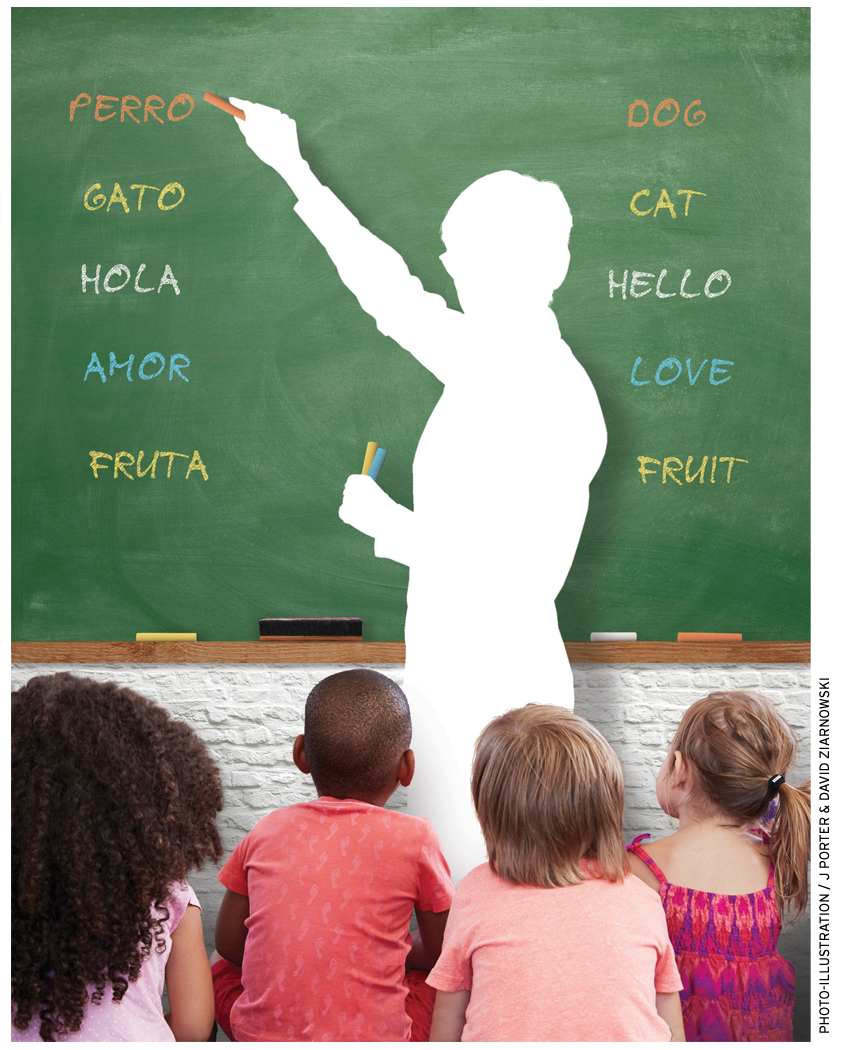 Bilingual education is on its way back in California.
Bilingual education is on its way back in California.
After decisively rejecting bilingual education in 1998, state voters enthusiastically endorsed its return in 2016. Educators are eager to offer more bilingual classes—and not only to recently arrived immigrants. Increasingly, English-speaking parents are also sold on the cognitive benefits of dual-immersion bilingual education for their own kids. One big factor, though, is holding back growth: a severe shortage of bilingual teachers.
“Every day, my phone rings off the hook,” says Cristina Alfaro, who chairs San Diego State University’s Department of Dual Language and English Learner Education. “Principals say, ‘I need a bilingual teacher. I need six teachers. I need someone right now.’”
No matter how much principals beg, Alfaro will not let her teachers-in-training start working before they’re fully qualified. “It’s not fair to students to have a teacher who’s learning on the job. I tell principals to ‘plan better. If you want a dual-immersion program, do it right. Maybe wait a few years until you can find the teachers. If you don’t have quality teachers, your program will fail.’”
The dual-immersion, or dual-language, model that predominates in California schools today centers on teaching students reading and subject content in two languages, and it aims for biliteracy. Spanish-English programs are the most common, but other languages, including Mandarin and Korean, are sometimes paired with English. Districts looking to offer dual immersion in these less-common languages have even more difficulty finding qualified teachers.
Traditional models of bilingual education teach English learners math, reading, and other subjects in their first language in kindergarten and 1st grade: often, only 10 percent of instruction is in English in the first two years. The goal is to transition students to all-English instruction as soon as possible. While this transitional approach is still common, virtually all new bilingual programs use the dual-immersion model, and some of the old ones are switching to it.
With dual-immersion programs burgeoning in California, school districts are competing fiercely for scarce teacher talent, bidding up compensation for bilingual educators in the manner of consulting firms recruiting new business-school graduates. Districts are stealing each other’s teachers, says Lucrecia Santibañez, an associate professor of teaching, learning, and culture in the School of Educational Studies at Claremont Graduate University. The Pasadena Unified School District, which expanded its dual-immersion programs from three schools to seven, “has been losing teachers to neighboring districts that offer higher salaries and, sometimes, signing bonuses for bilingual skills,” she says. “Teachers can go five miles down the road and make more.”
Los Angeles Unified, which is also ramping up dual-language instruction, offers an annual stipend of up to $5,406 to teachers with bilingual certification. Statewide, stipends vary from $1,000 (in San Francisco Unified) on up. A few districts pay as much as $5,000 as a hiring bonus.
In Sacramento, Natomas Unified pays an extra $5,000 for hard-to-find skills plus a $5,000 “diversity bonus” for experience working with racially, culturally, or academically diverse young people. The district, which hopes to start a dual-immersion school, is “struggling to find Spanish teachers,” says Amreek Singh, human resources director. “We’re all competing for the same group of people.”
Fifty-eight percent of districts surveyed in 2017 by Californians Together, a nonprofit coalition of organizations advocating for English learners, planned to add or expand bilingual programs, but 86 percent of the districts said the shortage of teachers is a “hurdle to realizing those plans.”
As California educators and policymakers talk of a new era of multilingual education, they’re careful to acknowledge that it won’t work without well-trained teachers.
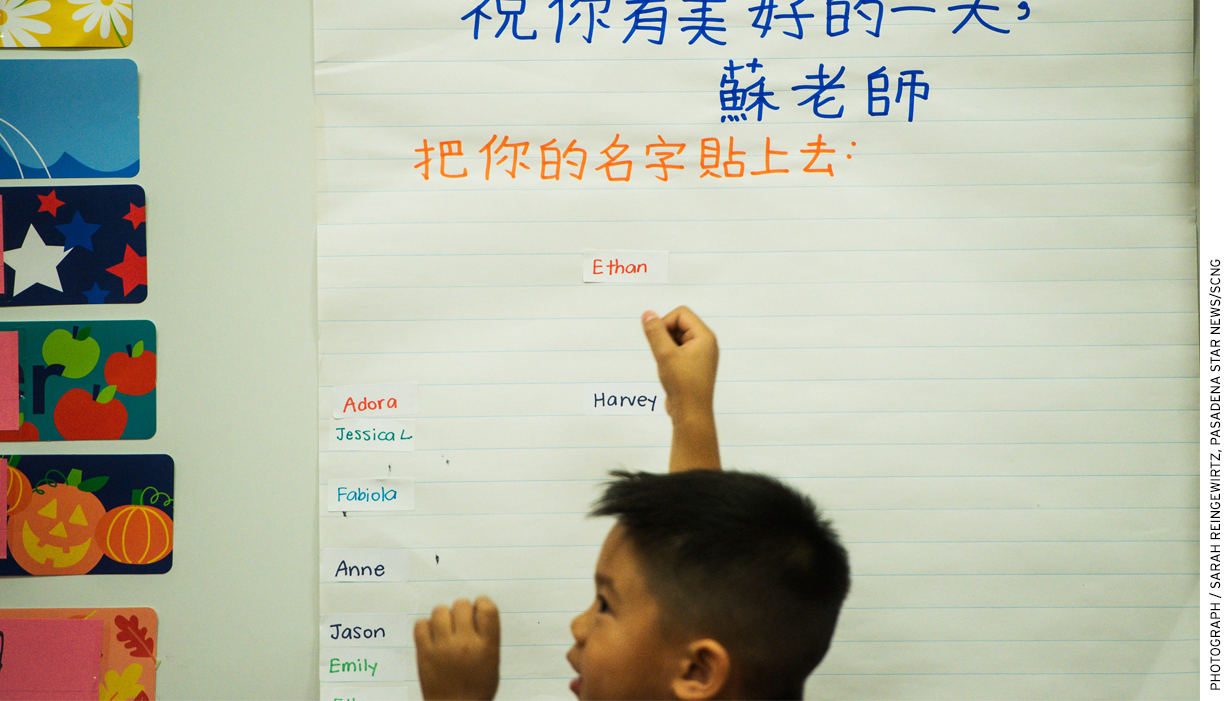
Learning from Past Mistakes
Nearly 1.3 million students in California public schools are classified as English learners. Twenty years ago, 30 percent of such students were taught in bilingual programs. In 1998, state voters approved Proposition 227, and the resulting statute required schools to teach in English unless parents signed waivers requesting primary-language instruction. The share of English learners in bilingual education fell to less than 5 percent.
Before 1998, faced with an acute shortage of teachers, schools often hired teachers without bilingual credentials or skills to lead bilingual classrooms. Sometimes, bilingual teacher’s aides taught reading.
“I would hope we’ve learned from history” not to offer bilingual classes without qualified bilingual teachers,” says Veronica Aguila, who directs the English Learner Support Division of the California Department of Education. Aguila got her start as a bilingual aide and later became a bilingual teacher.
Children from low-income and working-class Spanish-speaking families usually were placed in transitional classes in elementary school and were moved to mainstream English classes as quickly as possible. Most children did not develop strong speaking or reading skills in Spanish.
Some schools offered “developmental” or “maintenance” bilingual classes designed to improve students’ primary-language skills. Again, biliteracy was not the goal.
Expectations often were low, noted the Los Angeles Times in a 2006 editorial attacking a law proposing a simplified curriculum for English learners. “California was supposed to have learned a sad but important lesson from its years of experimenting with bilingual education: when you isolate a group of largely poor, minority students and give them different instruction from what other students receive, they tend to get a dumbed-down, second-rate education.”
In Lillie Ruvalcaba’s first year as a bilingual teacher, her 3rd graders moved from reading in Spanish to reading in English by midyear. The reader, called Ant About Town, “was written at the kindergarten level,” she recalls with a shudder. “‘Ant went up, up, up.’ It was such an insult to the students. We owe it to kids to have grade-level content taught in an interesting, motivating way.”
Ruvalcaba teaches at Mountain View Elementary District in El Monte, a mostly Latino town east of Los Angeles. When she was hired, she had a teaching credential, but not one with a concentration in bilingual-education methods. “If you spoke Spanish, you taught in Spanish,” she recalls. “We didn’t have the best-prepared teachers.”
After Proposition 227 passed, many of Mountain View’s bilingual programs closed. Ruvalcaba became a teacher of structured English immersion, a method that immerses students in English and provides supports to build students’ understanding. She now supports curriculum and instruction in English-learner programs.
The district is transforming its remaining bilingual program from a transitional to a dual-immersion model and hopes to open new bilingual classes at other schools. But, “we don’t want to repeat the mistakes of the past,” Ruvalcaba says. “Now we’re making sure we do it well.”
Nearly all new bilingual programs in California use dual immersion, a model that extends from kindergarten through 12th grade. Ideally, a class of dual-immersion students comprises a mix of children from English-speaking, Spanish-speaking, and bilingual families, with no one group predominating. The children of working-class immigrants learn with the children of middle-class and well-to-do parents. Native English speakers learn a second language as enrichment, while students from newly arrived families gain necessary fluency in English.
Alfaro of San Diego State calls dual immersion “the most powerful model for English learners—and for English-only students,” who stand to gain a “global edge.” By contrast, “the research is weak” for transitional bilingual education, she says. It gives English learners “a crutch” rather than equipping them with facility in both languages from the start.
Even critics of dual immersion concede it can work well if it is done right. But they warn that it’s hard to maintain quality while scaling up the number of programs.
Dual immersion is a risky choice for immigrant students, says Rosalie Pedalino Porter, who helped anti-bilingual crusader Ron Unz pass “English for the Children” measures in California and Arizona. It’s not enough to have “the right curriculum, the right books, and competent bilingual teachers,” says Porter, a former bilingual teacher and administrator in Massachusetts. “You also need a stable group of children who will stick with it” for five or six years. She chairs ProEnglish, a Washington, D.C.-based nonprofit that advocates for English immersion and making English the official language of the United States. But she also serves on the board of a Mandarin-immersion school that her granddaughter attended. The difference? Students in the Mandarin program are fluent English speakers immersed in a second language.
California’s education leaders say they understand that dual-immersion programs need qualified teachers and a solid curriculum. “Most districts are trying to build the foundation [for bilingual education] first, not creating programs for which they have no teachers,” says Marty Martinez, director of teacher induction for the Sacramento County Office of Education.
“We see people trying to do this right,” echoes Anya Hurwitz, director of the Sobrato Early Academic Language, or SEAL, program.
SEAL has developed a knowledge-rich curriculum for Spanish-speaking English learners in preschool through 3rd grade, which is designed to bring students up to grade level in subject areas by 3rd grade (see “Learning English,” features, Winter 2016). This year, about 100 preschools and elementary schools use SEAL in English or bilingual classes. Five of SEAL’s partner districts are expanding or adding bilingual programs, and SEAL is part of a consortium working on training and retraining bilingual teachers.
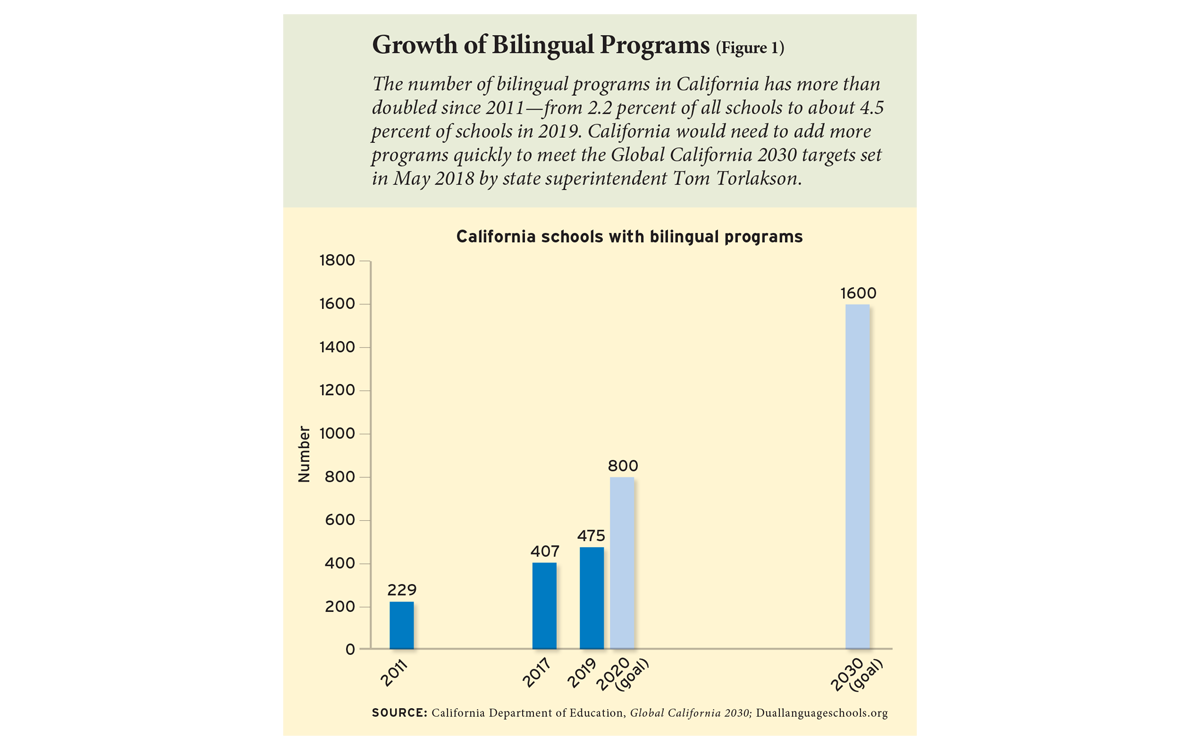
Global California
In May 2018, Tom Torlakson, the state superintendent, announced Global California 2030, an initiative to nearly quadruple the number of dual-immersion programs in the state, to 1,600 (see Figure 1); increase the number of bilingual teachers; expand access to “world language” classes; and encourage more students to earn a “seal of biliteracy” on their diplomas by the year 2030.
Tony Thurmond, who was elected in November 2018 to succeed Torlakson, is a staunch advocate of bilingual education. As a state legislator earlier that year, he sponsored a successful bill that earmarked $300,000 for the development of bilingual programs in the schools. He supports Global California 2030 and backed Proposition 58, a 2016 measure approved by 73.5 percent of voters that repealed the English-only requirement and opened the door to expanding bilingual ed in the state. In his campaign for superintendent, Thurmond promised to “continue to work to equip each school district with the resources they need to recruit and train language teachers who can guide our students into a globalized future,” and further pledged “to incorporate foreign language classes in the curriculum for elementary and middle schools so our younger students can get a head start on building this skill.”
In 2017 the state board of education adopted the English Learner Roadmap to guide policy in the Proposition 58 era. The plan envisions a “rich and challenging curriculum from early childhood to grade 12” that “respects the value of English Learners’ primary language and culture.” In addition to a “focus on English proficiency,” the road map calls for “proficiency in multiple languages—and recognition of the role of home language in supporting English and overall literacy.”
About 38 percent of California’s public-school students enter the system as English learners—more than double the national average. About 82 percent speak Spanish at home; Vietnamese, Mandarin, Arabic, and Filipino (including Pilipino or Tagalog) are the next most-common languages (see Figure 2). Most are born in the United States to immigrant parents and are likely to be reclassified as “fluent English proficient” within six years: to earn that designation, students must show they’re fluent in English and performing at or near grade level academically. The annual statewide reclassification rate, which hit 14.6 percent in 2017–18, has more than doubled since 1997–98.
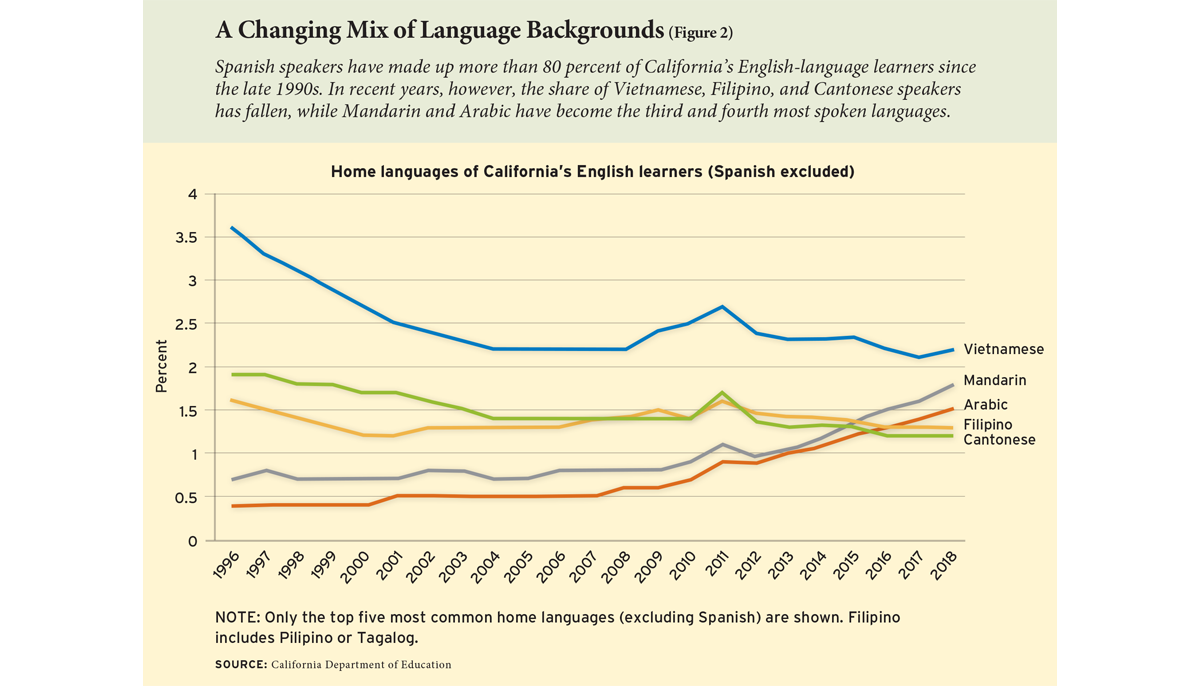
The state department of education doesn’t track the number of students in bilingual programs, says Aguila. The database was abandoned after the passage of Proposition 227 and has yet to be revived. She believes there are 469 dual-immersion programs in the state, based on a 2016–17 survey by the California Association for Bilingual Education, but she offers no guess on the number of programs using other models. These days, “bilingual” and “dual immersion” are sometimes used as synonyms.
In spring 2017, Californians Together partnered with the Association of California School Administrators and the state’s two teachers unions to survey 111 districts and charter schools enrolling 39 percent of California’s English learners. The survey found 27 percent offer dual immersion, 12 percent provide transitional bilingual education, and 5 percent have developmental or maintenance bilingual classes.
The Broken Pipeline
After Proposition 227 limited bilingual education, more than half the state’s teacher-preparation programs stopped offering training in the specialty, reports the California Commission on Teacher Credentialing. The number of new teachers earning bilingual credentials fell.
“[Proposition] 227 was devastating,” says Jan Gustafson Corea, chief executive officer of the California Association for Bilingual Education.
“The pipeline was broken,” says Eduardo R. Muñoz-Muñoz, who was recruited from Spain 12 years after 227’s passage to fill the bilingual teacher shortage. He earned his Ph.D. at Stanford and became an assistant professor of teacher education at San Jose State University.
Two years after Proposition 58’s approval, San Jose State has not seen a spike in demand for bilingual training, he reports. “There is untapped potential. We see bilingual people who want to be teachers but aren’t choosing to become bilingual teachers.”
In part, that’s because many people aren’t sure how much language proficiency is required to be a bilingual teacher, according to Muñoz-Muñoz. “What does it mean to speak ‘academic Spanish’ or ‘high-level Spanish’?” he asks.
To teach English learners in their primary language, California educators must earn a so-called bilingual authorization by passing a test of language, education theory, and culture (see Figure 3). The requirements changed in 2009. Many former bilingual teachers are studying “academic Spanish” to fortify their knowledge of the language.
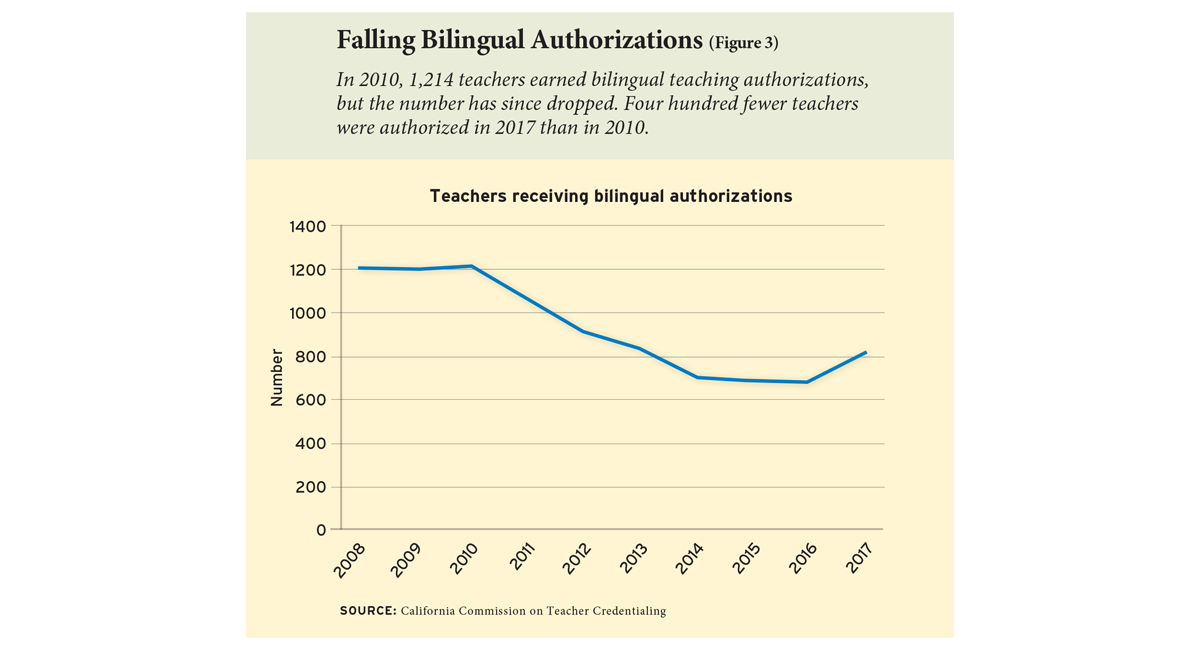
California needs to “unify how we’re preparing dual-language educators” and “do it right,” says Alfaro. Bilingual educators are “forming consortiums so we can work together to develop new state standards for preparing dual-language teachers. There’s a national effort as well.”
Education schools are pursuing faculty members who can train prospective teachers to teach bilingual education: it’s a hot market for new Ph.D.’s, says Alfaro.
San Diego State, which continued to prepare bilingual teachers even in the Proposition 227 era, has the faculty it needs to create new programs. Alfaro’s department has streamlined its curriculum to enable community-college students to complete a bachelor’s degree and teacher certification in four years instead of five. Some of the teacher trainees are bilingual aides. “They start in community college, do their practicum hours early to make sure they really want to be teachers, and complete their bachelor’s degree with a credential,” says Alfaro. Southwestern College, only a few miles north of the Mexican border, is a prime recruiting ground. Most of the college’s students are bilingual Latinos.
Schools are recruiting from Spain, Chile, Puerto Rico, Argentina, and elsewhere, says Alfaro. The problem is that foreign teachers “lack understanding of the cultural context,” the curriculum, and the Common Core standards, she says. Teachers from Spain “have strict rules for how Spanish should be spoken. They need to honor the Spanish their students speak, which is a border dialect.”
In addition, turnover is high for foreign teachers, who may be working on short-term visas, says Alfaro. For these reasons, she believes it makes more sense to train Californians than to hire from abroad.
“Some districts put interns in the classroom right away, with coaching,” Claremont’s Santibañez says. “English learners often are taught by new or early-career teachers, often with emergency credentials,” her research has found. “It’s a problem. It’s one thing to speak Spanish. It’s another thing to teach reading in Spanish.”
As in other areas of K–12 education, it’s not uncommon for the neediest English learners to get the least-experienced, least-trained teachers. A 2017 National Academies of Sciences, Engineering, and Medicine report found that teachers who work with English learners often are under-prepared.
Teachers prepared to work with English learners are in short supply nationwide, according to an analysis of federal data by the American Association of Colleges for Teacher Education. While 10 percent of public-school students are classified as English learners, only 4 percent of new teachers earned credentials in English as a Second Language instruction and 2 percent majored in bilingual, multilingual, and multicultural education.
California districts also are having trouble finding special education, science, math, and career-tech teachers. The state has made it easier for out-of-state teachers to become certified, and the California Commission on Teacher Credentialing is considering easing subject-matter testing requirements for new teachers. That step could make it easier for teachers to earn a bilingual authorization—but it also would risk lowering teacher quality.
Back to Bilingual Teaching
Education agencies, universities, school districts, and nonprofits are trying to increase the supply of bilingual teachers. While they hope to train new teachers, they’re starting with existing educators.
The Californians Together survey found 6,000 teachers with bilingual authorizations who are teaching in English-only classrooms and another 900 teachers who are fluent in another language but not certified for bilingual instruction. Former bilingual teachers are open to returning but feel they need support to improve their language and teaching skills, says Corea of the California Association for Bilingual Education.
The California Department of Education has awarded Bilingual Teacher Professional Development grants—each in the amount of $625,000—to four school districts and four county offices of education throughout the state. The Sacramento County Office of Education is partnering with seven local school districts, Sacramento State, and Loyola Marymount University to increase the number of bilingual teachers, says Martinez. Some teachers who earned a bilingual authorization never used it, while others may speak Spanish fluently but don’t know how to teach it, says Martinez. “Loyola Marymount works on building teachers’ academic language skills and pedagogy.”
Past and future bilingual teachers can take tuition-free evening and online classes at the university. The next step is to create a pathway to teaching for bilingual aides, some of whom already have bachelor’s degrees, says Martinez.
“We’re looking within our schools” to find teachers who are close to being ready to teach in bilingual classrooms, says Amy Boles, director of educational services in San Jose’s Oak Grove district. Oak Grove is managing a state grant for a 10-district consortium.
However, some credentialed teachers are reluctant to return to bilingual teaching, says Muñoz-Muñoz. “Being a bilingual teacher requires support, and those supports weren’t there in the past. We’re not sure how many we can recapture and perhaps retrain.”
In the East Bay town of San Lorenzo, Annalisa McHenry teaches 3rd grade in an early-exit transitional bilingual program that administrators hope to switch to the dual-immersion model next year. The district is working with SEAL to train more teachers, but it will be a struggle to staff the school, says McHenry. “Being a bilingual teacher is more work, and it isn’t more money.”
California has adopted a demanding, high-level English Language Development framework, says SEAL’s Hurwitz. “To achieve that in two languages requires a strong program. Bilingual teachers need planning, collaboration, and training time. We haven’t done that in the past.”
Priscilla Figueroa, an English Language Development coach in Mountain View Elementary, agrees that dual-immersion settings demand high-level teaching skills. She started teaching 29 years ago as a bilingual teacher with emergency credentials, but never finished certification. Like her colleague Lillie Ruvalcaba, she became an English-immersion teacher after Proposition 227 passed in 1998. She’s now one of a group of Mountain View teachers working to complete a bilingual credential.
“When I was a 5th-grade bilingual teacher, the better students transitioned to English in 3rd grade,” she recalls. Students still in bilingual classes in 5th grade were working below grade level. “You were teaching to a lower reading level.” Dual-immersion teachers are expected to teach grade-level academic content to all students, says Figueroa. “If I taught 5h grade, I’d have to teach 5th-grade science, social studies, math. I’d have to use all my teaching skills to scaffold instruction to achieve that.”
Alicia Raygoza, now a literacy coach in Mountain View, signed up for Loyola Marymount’s online “academic Spanish” program to polish her academic Spanish. She learned Spanish from her parents, but was educated in English and tested out of Spanish in high school, she says.
The dual-immersion model is supposed to continue in middle and high school, so students can become fully literate in both languages. However, finding bilingual secondary-school teachers is even harder than finding such educators at the elementary level. Spanish literature teachers are available, says Hurwitz, but middle and high schools need people who can teach science, social studies, and other subjects in Spanish.
Who Benefits?
Educated parents are leading the push for dual immersion in California and across the nation. That worries many of its supporters, who think the needs of English learners should come first. Bilingual education is enrichment for advantaged students but a critical necessity for those who need to master English.
Dual immersion comes with a tacit promise of desegregation, since it’s so popular with middle-class English-speaking parents, says Hurwitz. “But we have to understand the equity issue. Who is the program serving?”
Dual immersion “is the best public education has to offer,” says Muñoz-Muñoz. “My own child is in dual immersion.” But he worries about the “differential in power and social influence” between educated, English-speaking parents and English-learner parents. Dual immersion “is not delivering its promise to everybody,” he warns.
In Los Angeles Unified, it’s “marketed as enrichment, almost as a gifted program,” says Santibañez, who chose dual immersion for her own child. “There’s enormous growth in dual immersion, because districts have found it’s a way to keep middle-class parents in the district,” she says. Educated, middle-class parents tend to exercise vigilance over their children’s education, and their involvement can serve to ensure that dual-immersion programs don’t cut corners on quality. “Affluent parents are their kids’ biggest advocates,” Santibañez says, “while low-income parents don’t know if their kids are in low-level English classes.”
However, she has seen dual-immersion programs that primarily enroll children from middle-class, English-only families. Some immigrant parents felt unwelcome or intimidated by the English-speaking middle-class parents, says Santibañez. In a meeting with a large number of parents, for instance, if the staff asks, “‘Who needs translation?’ . . . they don’t want to raise their hands.”
Across the state, school officials report English-speaking parents are very interested in dual immersion, but Spanish-speaking parents have to be persuaded of its merits. Bilingual-education advocates say they’re trying to “educate” immigrant parents about research showing that bilingualism builds mental flexibility. In addition, they’re touting evidence that dual immersion is effective at building proficiency in both English and a student’s first language. The parents of English learners, however, don’t always believe that.
Immigrant parents “are very concerned their kids are not learning English fast enough,” Santibañez says, because during the child’s first years in a bilingual program, Spanish predominates over English. “Most dual-immersion programs start with lots of Spanish, then are fifty-fifty by 4th and 5th grade. Parents get worried and pull them out. We see a lot of attrition.”
Sticking with the program for the long haul is important, she notes, because it takes time for English learners to achieve proficiency in English if they’re taught primarily in their first language until 4th grade. If students quit in elementary school—or if schools don’t provide dual immersion in middle school—then many of the promised benefits may be lost.
“Hopeful” is the word bilingual-education advocates use most frequently. California has opened the door to a teaching model they hope will enable students to achieve fluency and literacy in two languages. But achieving that dream will require many more well-trained, bilingual, and biliterate teachers and sustained attention to maintaining quality and equity.
Joanne Jacobs is a freelance education writer and blogger (joannejacobs.com) based in California.
This article appeared in the Summer 2019 issue of Education Next. Suggested citation format:
Jacobs, J. (2019). To Bring Back Bilingual Ed, California Needs Teachers: Districts offer bonuses of up to $10,000 to woo scarce instructional talent. Education Next, 19(3), 18-26.


